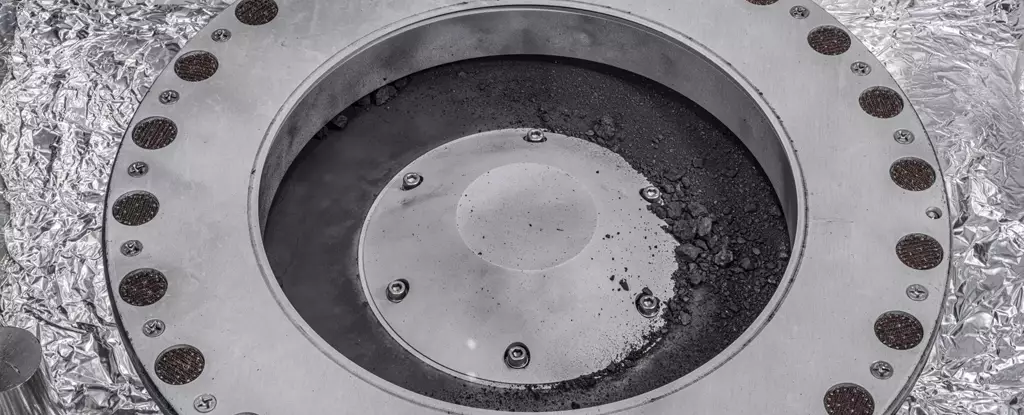In a groundbreaking revelation, NASA announced on Wednesday that a sample collected from the asteroid Bennu, which is approximately 4.5 billion years old, contains a significant amount of water and carbon. This discovery provides further support to the theory that life on Earth may have originated from outer space. The sample was obtained through the OSIRIS-REx mission, which involved a seven-year-round-trip to the distant rock and meticulous scientific analysis. The findings unveiled by NASA shed light on the composition of Bennu and offer valuable insights into the formation of habitable planets.
The preliminary analysis revealed that carbon accounted for nearly five percent of the sample’s total weight, present in both organic and mineral form. Carbon is a crucial element for life as it forms bonds with other elements, playing a vital role in the production of proteins, enzymes, and genetic codes such as DNA and RNA. Additionally, water was found to be locked within the crystal structure of clay minerals. This intriguing combination of carbon and water in the sample makes it an astrobiologist’s dream, providing a wealth of scientific opportunities for further study and analysis.
Exploration of Bennu
NASA’s OSIRIS-REx mission was not the first attempt to collect samples from an asteroid. Japan achieved this feat twice before, returning celestial dust in 2010 and 2020. However, the amount of material collected by the OSIRIS-REx mission significantly surpasses the quantities brought back by the Japanese missions. While Japan’s Hayabusa2 managed to collect only 5.4 grams, OSIRIS-REx captured an estimated 250 grams (half a pound) of asteroid material. This substantial collection opens up new avenues for researchers around the world to advance our understanding of asteroids and their role in the formation and evolution of our solar system.
Named after an ancient Egyptian deity, Bennu is a remarkable celestial body preserved in the vacuum of space, making it an incredibly valuable target for scientific study. Its orbit, which intersects with that of Earth, facilitated the mission, enabling a more accessible journey compared to asteroids located in the Asteroid Belt between Mars and Jupiter. By analyzing Bennu’s composition, scientists hope to gain a better understanding of the asteroid’s history, which could prove crucial if humanity ever needs to devise a strategy to divert its trajectory away from Earth. Although the risk of Bennu colliding with our planet is minimal in the mid-2100s, the probability increases to approximately 1 in 1,750 between then and the year 2300, as estimated by NASA.
The data gathered by the OSIRIS-REx spacecraft has revealed intriguing details about Bennu’s exterior. The particles comprising the asteroid’s surface are so loosely packed that a person stepping onto it would likely sink in, reminiscent of a pit of plastic balls in children’s play areas. However, researchers have primarily focused on the “bonus particles” present on top of the sample collecting mechanism, rather than the main sample itself. Further examination of the remaining sample is still pending, promising more exciting discoveries in the future.
Preservation and Public Display
NASA plans to preserve at least 70 percent of the sample at the Johnson Space Center in Houston for future study. This preservation practice follows in the footsteps of the Apollo era, where Moon rock samples were also stored for future examination and new scientific techniques. By preserving the Bennu sample, scientists can delve into new research questions, employ novel methodologies, and utilize evolving instrumentation for extensive analysis for years to come. Additionally, select pieces of the sample will be sent for public display at prestigious institutions such as the Smithsonian Institution, Space Center Houston, and the University of Arizona, granting the public an opportunity to witness a fragment of the ancient asteroid.
The discovery of abundant water and carbon on the asteroid Bennu provides compelling evidence for the theory of extraterrestrial origins of life on Earth. Through meticulous analysis and advanced scientific techniques, NASA has unraveled fascinating details about Bennu’s composition and its potential as a habitable planet. This groundbreaking research opens up new avenues for exploration and reinforces our understanding of the vast universe surrounding us. The study of asteroids and their significance in the formation of planets continues to captivate scientists and astronauts alike, as they strive to unlock the mysteries of our cosmic origins.


Leave a Reply